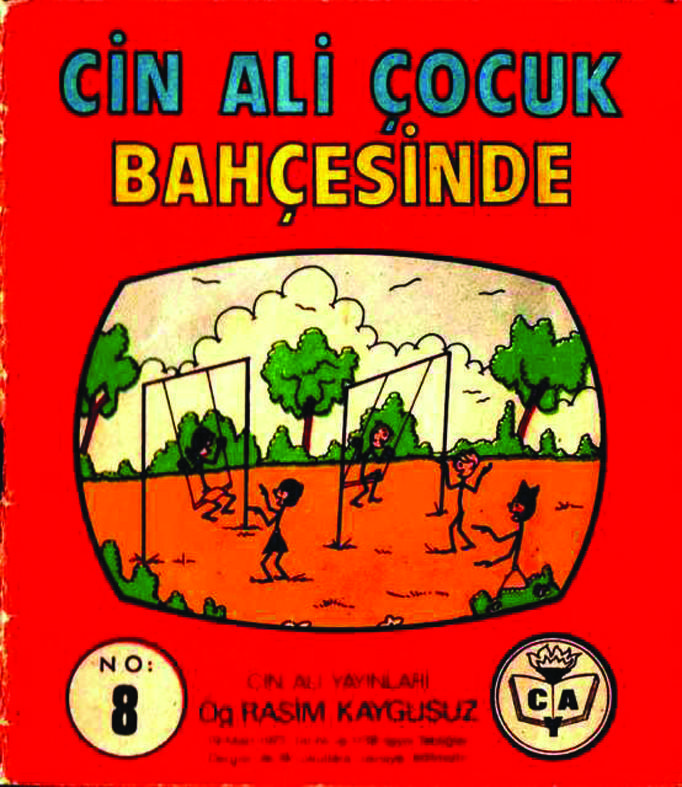The return of a childhood icon, Cin Ali
Emrah Güler ANKARA

The stick figure in a cap peering through a set of ten books, created by primary school teacher Rasim Kaygusuz in the late 1960s, has penetrated into the collective conscience of generations.
Cin Ali not only has helped many generations how to read, but continues to be one of the most prominent figures in Turkey’s pop culture. The stick figure in a cap peering through a set of ten books, created by primary school teacher Rasim Kaygusuz in the late 1960s, has penetrated into the collective conscience of generations.
From the comedy sketches of the stand-up comedian and actor Cem Yılmaz to the talk show host Beyaz’s TV program, and the subject of an elaborate tapestry exhibition last year, Cin Ali remains relevant today. “I can’t even draw Cin Ali,” is a common phrase in Turkish, in reference to the simple drawings of the children’s books.
The 10 books, 20 pages of the familiar square shape, were published last September true to their original forms, each black and white, with only the 10th one illustrated in color. Until a decade ago, the books were part of the curriculum for first grades.
The revival of the iconic figure, who is the first literary protagonist met by many generations in Turkey, has begun thanks to the efforts of Nevin Kaygusuz, the daughter of the creator and writer of the Cin Ali Books. The Hürriyet Daily News talked to Kaygusuz, who usually works in the conservation of architectural heritage, and has now turned to a cultural heritage dear to her own heart.
Beauty of simplicity“My father was a primary school teacher for 27 years, and a first grade teacher for 17 of these years,” said Kaygusuz. “He thought it was very important to be a first grade teacher. That it should be an altogether separate specialty.” After 17 years of teaching in primary schools, Rasim Kaygusuz came up with the idea of a new set of books that would help children learn how to read.

The Cin Ali books have a brilliantly simple structure, a few sentences on each page with stick figures, illustrated by Selçuk Seymen, for the children to be able to draw on their own. The very first page of the first book “Cin Ali’nin Atı” (Cin Ali’s Horse) features only the following words, “Cin Ali, look! Horse.
Look, Cin Ali, look. This is horse. Dad, get me that horse,” accompanied by the stick figures of Cin Ali, his balding dad with glasses, and a happy horse. “The first book has only 20 words, said Kaygusuz. “Each book becomes slightly more difficult than the previous one.” For many who have studied primary schools in the 1970s and 1980s, “Cin Ali’s Horse” is the first book they have ever read. “A child learns how to read, then starts reading the Cin Ali books, then moves on to other books,” said Kaygusuz.
What lies behind the appeal of the Cin Ali books to children who have just learned to read? “There is a coherent narrative where the child feels that he/she is reading a book. There is a story in each book,” said Kaygusuz. “That’s why the pirate versions cannot replace the original. They just put together a bunch of words, a few simple figures, with no narrative structure, with no story.” According to Kaygusuz, there have been around 30 pirate versions of the Cin Ali books with names like Can Ali, Bıdık Ali and Tonton Ali, which were especially produced in the early 1980s. “The Cin Ali books were the first books to have pirate printing in Turkey,” said Kaygusuz.
A portrayal of city life in the 1960sRasim Kaygusuz spent most of his teaching career in Ankara, where he welcomed many teachers across Turkey and taught them the systems he had developed for reading and writing, including a teaching apparatus that he designed and produced, called “Çözümlü Alfabe” (Alphabet with Solutions). The circular-shaped apparatus helped children complete words and sentences, and eventually create stories. Orders for the Cin Ali books were also coming from around Turkey, his wife Remziye Kaygusuz helping with the orders. Nevin Kaygusuz remembers a rush in her childhood house in Ankara where they used to check the orders and send them through the post office to different parts of Turkey.
Through the Cin Ali books, you can also get a glimpse of city life in 1960s, a picture far from the concrete, the overpasses and the shopping malls of today. “Cin Ali books give an accurate portrayal of city life in the 1960s,” said Kaygusuz. Cin Ali’s nuclear family of a father, a mother, and two older sisters were inspired by Rasim Kaygusuz’s own family. “I was the younger sister,” said Nevin Kaygusuz. In real life, the sisters’ names were Nevin and Nesrin, while in the books they are Suna and Selma. Nevin Kaygusuz and the family are now quite close to opening a Cin Ali Foundation. The revival of an icon of nearly half a century seems to be in full swing.

 The Cin Ali books have a brilliantly simple structure, a few sentences on each page with stick figures, illustrated by Selçuk Seymen, for the children to be able to draw on their own. The very first page of the first book “Cin Ali’nin Atı” (Cin Ali’s Horse) features only the following words, “Cin Ali, look! Horse.
The Cin Ali books have a brilliantly simple structure, a few sentences on each page with stick figures, illustrated by Selçuk Seymen, for the children to be able to draw on their own. The very first page of the first book “Cin Ali’nin Atı” (Cin Ali’s Horse) features only the following words, “Cin Ali, look! Horse.